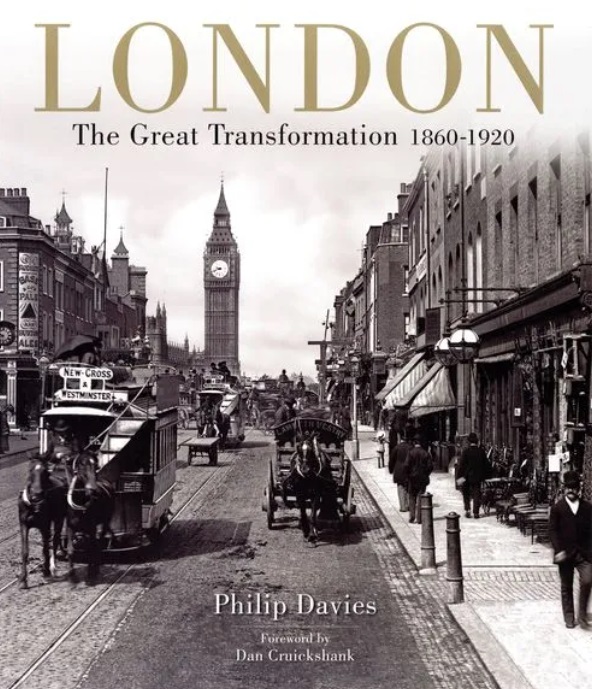London: the Great Transformation 1860-1920
London: the Great Transformation 1860–1920, Atlantic Publishing, 480 pages, over 800 black-and-white illustrations, hardback, 2022.
This book is the fourth of Philip Davies’s explorations of London through historic photographs. In this volume the author draws on a wide range of archive material, particularly on photographs in the Historic England archives and at Bishopsgate Institute.
In a foreword, Dan Cruikshank notes that it is often the most obscure that is lost. The book shines a light on less-known but changed corners of London. The large number of timber-framed and weatherboarded houses in areas like Clerkenwell and Stepney, and in then-outlying villages like Hornsey, come as a surprise. Equally unexpected is the foreground in 1867 of wharves and industrial buildings between Lambeth Bridge and the Palace of Westminster and the abbey: a place that is an important element in the nation’s image of itself. True to its title, the book illustrates a great transformation from a London that would be recognisable to Charles Dickens to a city still familiar in the mid-20th century.
In his author’s introduction, Davies traces the depiction of London before photography and the subsequent history of photography in the capital. The book includes the earliest-known photograph of London: a view of Whitehall taken in 1839. Photography provided a record of the buildings and streets of London, and those form the core of the book, including work by photographers such as Bedford Lemere and Co. To take one example from hundreds, photographs of Edward Blore’s east front to Buckingham Palace in 1890, refaced in 1913, show that some changes were beneficial.
Some photographers had a deliberate social reforming purpose. Practitioners like John Thomson and the American author Jack London went into the poorer boroughs of the city to depict the lives of the people living there. Pictures of shops and people at work show a lively street life and a visually busy scene. Others depict the more abject face of urban poverty in a way which is uncomfortable to look at. Perhaps there is also a niggling worry that, for all the social reforming motives of the photographers, the pictures seem a little bit voyeuristic.
A photograph by Nora Smyth of a street in Bow in 1914 is one of the more harrowing images of poverty. Even there a boy poses as if in mid-air, with one foot on a window cill and the other in a cavity in the brickwork lining the alley, displaying something of the cockiness and confidence of Londoners that often shines through. In another photograph, a group of much better clothed and shod lads in Poplar in 1928 sit on a doorstep grinning at the camera.
Beyond the rich architectural record and the poignant images of thousands of people who were once flesh and blood, fixed by the camera shutter, the fascination of the book is in the particularity of the moment. Groups of people pose for the photographer in Tower Hamlets in 1912 while in the background a newsagent’s placard gives the news of the sinking of the Titanic. In Shoreditch in 1910 two police officers attending a school strike against corporal punishment question a photographer who nervously holds his camera behind his back: a scene captured by a second photographer.
When the postman handed me this book, he warned that ‘it’s got some weight’. This is true in every sense. The hundreds of photographs are both informative and haunting. This is a generous collection with a rich visual texture helped by cleaning and restoration of the plates. There are many forms of conservation. This book is the result of years of research and editing. The introduction and commentary inform the reader about the history of photography as well as about London’s and the nation’s history. London: the Great Transformation is itself a significant conservation achievement.
This article originally appeared as ‘Particular moments’ in the Institute of Historic Building Conservation’s (IHBC’s) Context 176, published in June 2023. It was written by Michael Taylor, editorial co-ordinator for Context.
--Institute of Historic Building Conservation
Related articles on Designing Buildings
- After the Fire: London churches in the age of Wren, Hooke, Hawksmoor and Gibbs.
- Brick.
- Conservation area.
- Conservation.
- Heritage.
- Historic environment.
- IHBC articles.
- Institute of Historic Building Conservation.
- London brick by brick.
- London Bridge and its houses, c1209-1761.
- Mortar.
- Pointing.
- Practical Building Conservation: Earth, Brick and Terracotta.
- The influence of geology on English brickmaking.
- The Livery Halls of the City of London.
- Types of bricks.
IHBC NewsBlog
Purcell’s guidance on RAAC for Listed Buildings in England & Wales
The guidance specifically focuses on Reinforced Autoclaved Aerated Concrete (RAAC) in listed buildings.
IHBC Membership Journal Context - Latest Issue on 'Hadrian's Wall' Published
The issue includes takes on the wall 'end-to-end' including 'the man who saved it'.
Heritage Building Retrofit Toolkit developed by City of London and Purcell
The toolkit is designed to provide clear and actionable guidance for owners, occupiers and caretakers of historic and listed buildings.
70 countries sign Declaration de Chaillot at Buildings & Climate Global Forum
The declaration is a foundational document enabling progress towards a ‘rapid, fair, and effective transition of the buildings sector’
Bookings open for IHBC Annual School 12-15 June 2024
Theme: Place and Building Care - Finance, Policy and People in Conservation Practice
Rare Sliding Canal Bridge in the UK gets a Major Update
A moveable rail bridge over the Stainforth and Keadby Canal in the Midlands in England has been completely overhauled.
'Restoration and Renewal: Developing the strategic case' Published
The House of Commons Library has published the research briefing, outlining the different options for the Palace of Westminster.
Brum’s Broad Street skyscraper plans approved with unusual rule for residents
A report by a council officer says that the development would provide for a mix of accommodation in a ‘high quality, secure environment...
English Housing Survey 2022 to 2023
Initial findings from the English Housing Survey 2022 to 2023 have been published.
Audit Wales research report: Sustainable development?
A new report from Audit Wales examines how Welsh Councils are supporting repurposing and regeneration of vacant properties and brownfield sites.


















